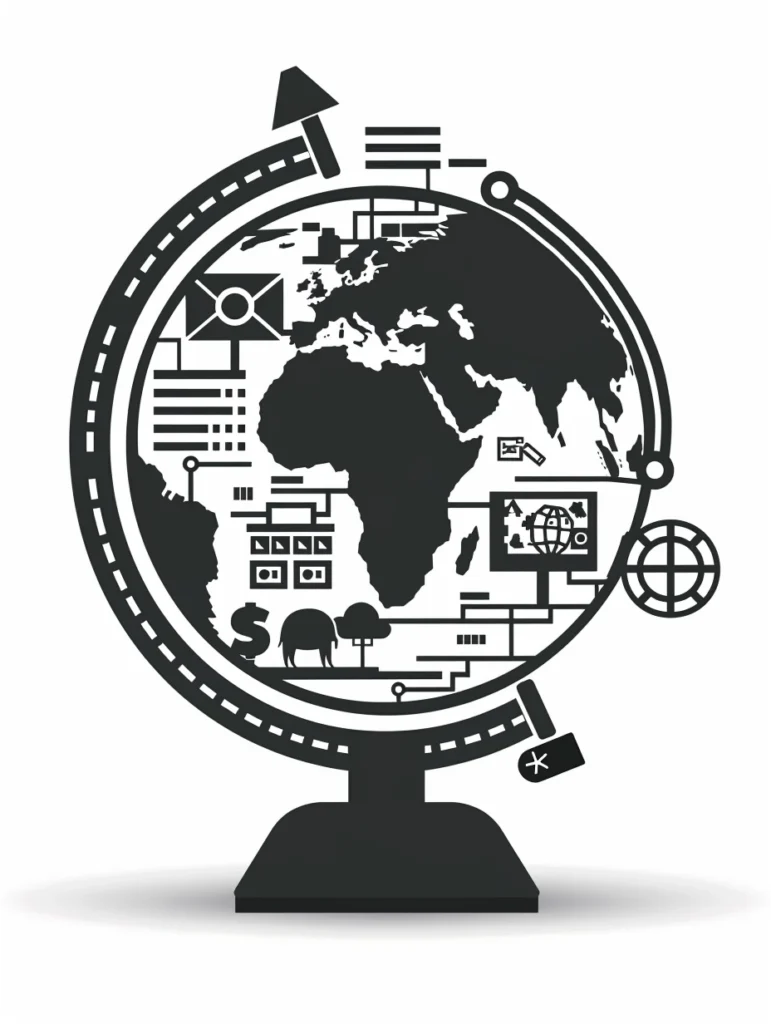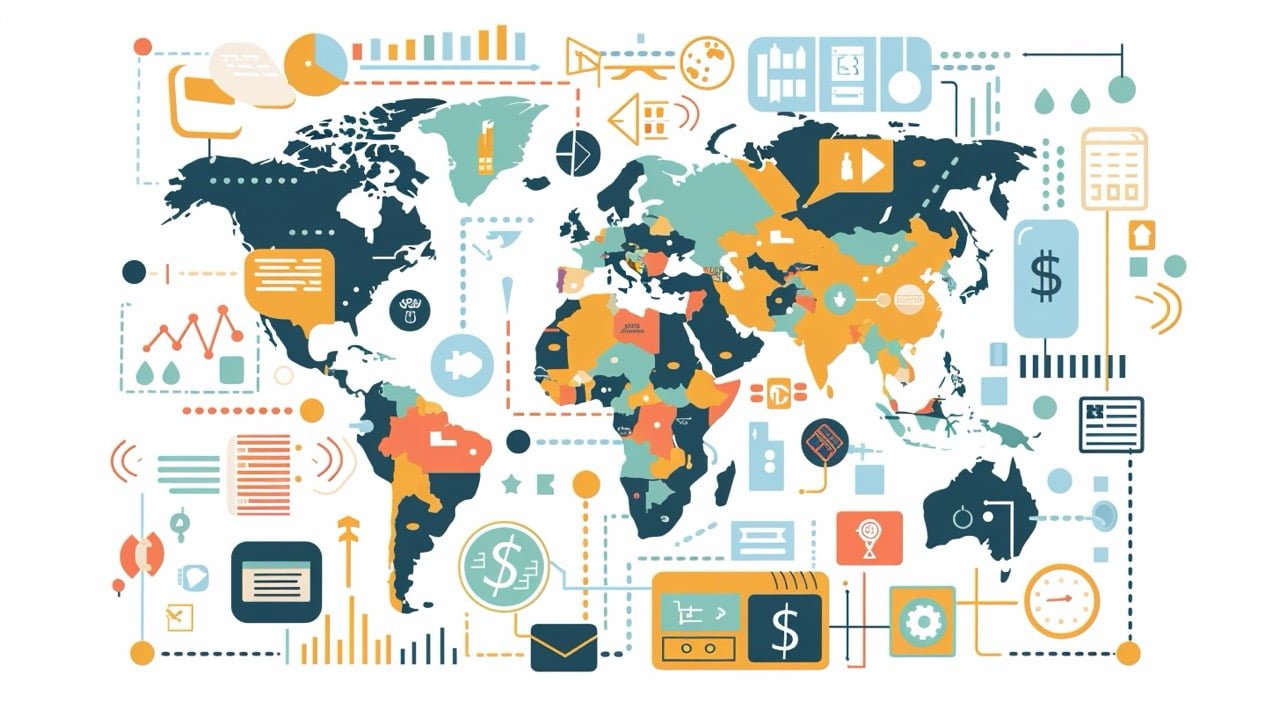The importance of adapting products to meet the specific needs of diverse markets cannot be overstated in today’s landscape of tech and online business sectors. The practice of product localization goes beyond translation and involves tailoring products to align with local cultures, preferences, and regulatory requirements.
For small business owners and startup founders looking to expand their reach, there is much to be learned from how some of the biggest names in tech have approached product localization to effectively communicate with a local audience. This article explores how notable tech giants like Google, Salesforce, Shopify, and Adobe have approached internationalization, providing concrete product localization examples and insights that small business owners and startup founders can draw inspiration from as they look to expand their own offerings.
Isn’t Product Localization Just Translation?
Product localization involves adapting a product’s design, functionality, and content to cater to different geographical markets. The process can span everything from translating text to modifying visual elements and adjusting technical specifications to meet local standards and practices. The goal is to provide a seamless and culturally relevant user experience that resonates with users in each target market.
For tech and online businesses, product localization is crucial for expanding reach, enhancing user engagement, and building a global brand presence. Regardless of how big or small your operation is, you ultimately want to acknowledge the uniqueness of every market and make users feel valued and understood, no matter where they are in the world.
The Benefits of Product Localization
Effective product localization offers numerous advantages for tech companies aiming to penetrate foreign markets, including reaching a wider target audience. There’s a lot of overlap here with the boons localization can bring to your business strategy, but these four big wins are worth mentioning again:
- Enhanced User Experience: By providing products that speak the user’s language and cater to their cultural preferences, you can significantly improve customer satisfaction and engagement.
- Market Expansion: Localization enables your business to enter and thrive in new markets by making your products accessible and appealing to local consumers.
- Customer Trust: Tailoring products and services to meet local expectations helps build trust and credibility among new users, and this in turn fosters brand loyalty.
- Competitive Edge: By effectively localizing your offerings, you can differentiate your brand from competitors who may not have taken the same care to adapt their products and services to the respective markets.
Key Areas of Product Localization

To better understand the scope of product localization, it’s important to recognize the various areas in which localization efforts are applied. There are four key areas of product localization that help companies create a comprehensive and culturally relevant user experience:
- User interface (UI) and user experience (UX) localization refers to the adaptation of a product’s visual elements, layout, navigation, and marketing materials to better suit the cultural norms and expectations of the target audience. This generally includes translating text, symbols, and graphics to reflect local languages, idioms, and even visual preferences.
- Translating and localizing product documentation and help center content ensures that user manuals, onboarding guides, tutorials, or help sections are available in the local language, and provide clear instructions and assistance to users in their native tongue.
- Adapting payment methods and localizing pricing means that any payment options you’re offering should be widely used and trusted in your target market. Your local payment gateways, currencies, and pricing structures all have to align with regional standards.
- Localizing marketing and promotional materials is another focal point. You want your marketing campaigns, advertisements, and any promotional content to really resonate with the cultural values, preferences, and sensitivities of your specific target markets. This can be as simple as translating marketing messages and using culturally appropriate visuals, and can get more involved if you find you need to create new campaigns or editorial content from scratch, such as when you want to include a nod to regional holidays and local traditions in your marketing efforts.
Product Localization Examples in Action

Google’s Localization Strategy
I haven’t been to Alphabet HQ in a while, but it’s fair to say they’ve exemplified the power of an incredibly robust product localization strategy, however fragmented it may be internally. From Google Search and Maps to its suite of platforms like Android and services such as Gmail, YouTube, Translate, Drive, and Gemini AI, Google has localized its extensive range of product offerings for literally hundreds of different markets around the globe. What I noticed when I visited Mountain View is that these localization efforts are often handled by a subset of specialists within individual product marketing teams at Google.
Where do localization teams sit within an organization?
It’s worth noting that the placement of l10n teams within tech companies varies widely. Some, like Google, distribute their efforts across product teams, other companies have a more centralized localization department similar to the one I built at Tumblr. That department, however, might be nested under the hood of Engineering, Product, Marketing, or something different entirely.
This disparity reflects the ongoing debate about the optimal structure for localization in the org chart. Some argue for embedding it within Product to ensure deep understanding of product nuances. Others advocate for a central group to leverage expertise and resources efficiently. There is no one-size-fits-all answer; I always say it’s going to come down to what your product is, how large your organization is, and what the scope of localizable assets looks like which you’ll be dealing with. Very generally speaking, I advocate for autonomous Language Operations that can straddle all touching points. Regardless of localization’s departmental home, Google’s success story underscores the importance of a strong l10n strategy.
They’ve not only translated content into local languages but also adapted their very algorithms to reflect regional search interests. The result of this effective product localization strategy is a highly personalized user experience that has solidified Google’s position as a global leader in internet services to the point that it’s become a monopoly under antitrust investigation, what with a 90% and 95% share of desktop and mobile, respectively.
Interesting side note: Google does not advise relying on Google Translate for user-facing localization efforts. They actually recommend using a human translator!
Case Study: Google Lens
While Google Maps is a well-known example of linguistic localization, another Google product that excels at product localization is Google Lens. This AI-powered visual search tool leverages computer vision to empower users around the world to identify objects in real-time, translate text, and interact with their surroundings.
One key aspect of Google Lens’s “loc” strategy has been adapting the visual recognition capabilities to accommodate diverse cultural contexts. For example, in markets where scanning text in traditional scripts like Chinese, Arabic, or Cyrillic is common, Google has fine-tuned Lens’s optical character recognition to detect and translate these languages.
Similarly, the product’s ability to identify local landmarks, retail products, and even cuisine has been tailored to provide relevant and meaningful information to users in each target region. For instance, scanning a food image might surface menus from nearby restaurants, or Lens might suggest local ride-hailing apps when a user points it at a taxi stand.
Beyond just translating interface text, the Google Lens team has worked to inject the product experience with culturally-specific features. This includes surfacing recommendations for nearby points of interest, integrating with popular local apps and services, and even adapting the visual aesthetics to align with regional design preferences. By taking a holistic approach to localization like this, Google Lens has been able to deliver a seamless, contextually “aware” experience that resonates with users worldwide.
Salesforce’s Globalized CRM Platform
Salesforce, the world’s leading customer relationship management (CRM) platform, has also mastered the art of product localization under the expert wing of Teresa Marshall, who’s been steering localization since 2009. By localizing its user interface and functionalities, Salesforce caters to businesses around the world, offering a CRM solution that meets the specific needs of diverse markets. Features such as multilingual support, customizable data fields, and adaptability to various business practices and regulatory standards have made Salesforce indispensable to international companies managing global customer bases.
Case Study: Salesforce Multilingual Support
As a leading global CRM platform, Salesforce has placed a strong emphasis on providing comprehensive multilingual support to its diverse user base. This localization effort goes beyond just translating the UI – it extends to all aspects of the product experience.
At the core of Salesforce’s multilingual strategy is the ability for users to interact with the platform in their preferred language. The CRM software offers full support for 18 languages and end-user or platform support for another whopping 144 languages, allowing customers worldwide to navigate menus, access features, and view data in their native language. But Salesforce’s localization efforts don’t stop there.
The company also ensures that all supporting documentation, training materials, and customer service resources are available in multiple languages. Users can access detailed help guides, instructional videos, and responsive technical support in the language of their choice. Whether they’re sales professionals, administrators, or developers, this attention to comprehensive linguistic support helps Salesforce customers quickly become proficient with the platform and turn around and deliver a superior experience to their own customers.
To further enhance the global UX, Salesforce even allows customers to build multilingual websites and online communities directly within the CRM with their TranslationWorkbench. This empowers international teams to tailor content, branding, and functionality to local market preferences, fostering deeper engagement and trust.
In prioritizing multilingual capabilities across its entire product ecosystem, Salesforce has set a high bar for software localization. This holistic approach ensures that users worldwide can fully leverage the power of the Salesforce platform, regardless of their native language or geographic location.
Shopify’s E-commerce Localization Efforts
I don’t think it’s any over-exaggeration to say that Shopify has helped revolutionized the e-commerce sector; it’s not only enabled solopreneurs to enter the playing field, but also allowed online merchants to easily create multilingual storefronts and accept payments in multiple currencies.
Case Study: Localization Made Simple at Shopify
Shopify understands the power of a global marketplace and they’ve empowered merchants to create culturally-sensitive shopping experiences that resonate with international customers.
At the heart of this strategy lies the “Markets” feature, which streamlines the creation and management of multilingual storefronts, allowing sellers to cater to the specific linguistic needs of local audiences. This includes translating product descriptions, pricing information, and the checkout process, ensuring a seamless purchase journey for customers worldwide.
Shopify has also been hugely successful in currency management, allowing merchants to set prices and accept payments in various currencies. This eliminates the need for conversions and is an overall better experience for international markets. Additionally, Shopify’s platform enables SEO optimization for multilingual storefronts, so that even the tiniest one-man shop in Timbuktu has a chance of discoverability in regional search results.
Perhaps the most impressive aspect of Shopify’s approach is the flexibility it offers in content management. Merchants can get more granular in the tailoring of their product descriptions, marketing copy, and promotional messages. This ability to create culturally-specific experiences has the potential to build stronger connections with international customers and build brand loyalty on a global scale.
Adobe Localization
By now it’s pretty clear that a successful localization strategy goes beyond simply translating menus and buttons. You can avoid the mishaps of poor communication by understanding the cultural nuances and workflows of your target audiences. Adobe is one more example of a major player in tech that executes such a strategy, as exemplified in its ubiquitous premium software product.
Case Study: Localizing Adobe Photoshop for the Global Creative Community
Adobe, a leader in creative software, prioritizes localization to empower creatives worldwide. This commitment is evident in Adobe Photoshop, arguably the most popular image editing software on the planet. Photoshop is available in 24 languages, allowing users to navigate the interface, access tools, and work with familiar labels and commands in their preferred language.
Adobe has incorporated localized features that cater to the specific needs of global users, including support for different keyboard layouts, right-to-left language interfaces for Hebrew and Arabic, and the ability to work with both metric and imperial measurement systems. Additionally, Photoshop adapts date and time formats based on regional conventions for a seamless UX. Users can further personalize their workflow by choosing their preferred interface language from within the software settings.
But Adobe takes localization a step further with Photoshop’s plugin ecosystem. Designers and artists can leverage specialized localization plugins developed within the UXP ecosystem to translate and customize visual elements like text layers, brushes, and even entire UI skins. This empowers global creatives to seamlessly adapt Photoshop to their local language, cultural aesthetics, and workflow preferences.
With their commitment to localization, Adobe has ensured that Photoshop remains a premier creative tool for artists and designers everywhere.
Overcoming Challenges in Product Localization
Despite the significant benefits of product localization, tech companies in particular often face a range of challenges when adapting their offerings for global markets. Navigating cultural nuances and sensitivities can be particularly complex, as product features and marketing messages that resonate in one region may fall flat or even offend in another. Ensuring technical compatibility across diverse devices, operating systems, and network environments prevalent in different markets also requires careful consideration.

Equally important is maintaining consistency and quality control throughout the localization process. Preserving a cohesive user experience, brand identity, and software functionality across multiple localized versions is vital for meeting the expectations of international customers. Rigorous localization testing helps verify the accuracy and usability of translated content, but coordinating these efforts across distributed teams can introduce additional logistical hurdles.
By addressing these challenges head-on, tech companies can create great localized product experiences that resonate with users in different markets and enhance their chances of international success. This often requires close collaboration between internal teams, leveraging specialized localization tools and automation, and seeking guidance from in-country experts who understand the target markets at a more granular level.
Best Practices for Successful Product Localization
If you want to localize your product or service, there are a range of best practices your localization team should run with. For brevity’s sake, these would be my top four:
- Conduct thorough market research and user testing: Gain in-depth knowledge of target markets, including cultural nuances, user preferences, and local competitors. Test localized versions of the product with real users to gather feedback and then iterate accordingly.
- Utilize localization tools and automation: Leverage modern localization tools and automation platforms to streamline the localization process. These tools can help manage translation workflows, ensure consistency, and facilitate collaboration between different teams working on localized content.
- Collaborate with in-country experts and translators: Seek assistance from in-country experts, translators, or localization agencies who possess the necessary linguistic and cultural expertise. Their insights and guidance can significantly improve the effectiveness of the localization efforts.
- Ongoing monitoring and adaptation of localization efforts: Localization is an iterative process. Continuously monitor user feedback, conduct localization testing, and stay on top of market trends and emerging opportunities to refine and adapt the localization strategy over time.
By adhering to these best practices, you can maximize the impact of your product localization efforts with relatively low overhead to create an engaging and culturally sensitive experience for users. Check out my Best Practices category here on Modilingua’s blog if you’d like to dive deeper into the subject matter.
Looking Ahead & Key Takeaways
As technology continues to advance, the future of product localization looks promising. Emerging trends, such as AI-driven localization and real-time translation, are set to further enhance the ability of any-sized company to tailor its products for global audiences. With the increasing demand for personalized user experiences, localization will continue to play a pivotal role in enabling businesses to connect with users worldwide.
As markets become more interconnected and diverse, successful tech companies in particular will need to stay ahead of localization trends and invest in innovative solutions to effectively reach and engage users across the globe.
Product localization plays a critical role in the global expansion strategies of tech and online businesses. By examining product localization examples from industry giants like Google, Salesforce, Shopify, and Adobe, it’s clear that successful localization can significantly impact a company’s ability to connect with users worldwide.
Product Localization Strategy for Small Businesses and Startups

Even small businesses and bootstrapped startups can benefit immensely from implementing similar localization strategies. Drawing inspiration from the above product localization examples, here are some practical tips to get you going:
- Start simple, but think globally. You don’t need a complete localization overhaul right away. Begin by translating your website and marketing materials into a key target language. Research your audience and prioritize languages with the highest potential for your business.
- Prioritize user experience. Localization goes beyond just translation. Consider cultural nuances and adapt your content to your market. This includes things like date and time formats, currency symbols, measurement units, and other regional preferences.
- Leverage technology. There are many affordable translation tools and platforms available, from basic solutions like Google Translate to more robust translation management systems (TMS) as your business grows. Explore options that fit your current needs and budget.
- Content is king. High-quality, informative content is essential for any business. Create valuable content that resonates with your target audience, and consider translating it into different languages to expand your reach.
- Start small, scale up. Focus on a single target language initially. As your business grows and resources allow, you can expand your localization efforts by translating into more languages.
Additional Tips for Bootstrapped Startups:
- Community translation: Explore online communities where native speakers might be willing to help translate your content in exchange for exposure or credits. I’m personally not a fan of crowdsourcing, but I can see how it might work for the likes of a small app.
- Partnerships: Look into partnerships with local businesses or influencers in your target market. They can help you adapt your content and marketing strategies for their region.
- Focus on SEO: Optimize your website content and metadata for search engines in your target language to ensure discoverability. This is such a low-hanging fruit, yet so many small businesses get it so wrong.
Localization is ongoing, not a one-time project. By starting small, prioritizing user experience, and leveraging available resources, even a bootstrapped startup can reap the benefits of a well-executed localization strategy and unlock new opportunities for growth.

As the tech industry continues to evolve, the importance of thoughtful, culturally sensitive product localization will only grow. By understanding the benefits, challenges, and best practices of product localization, tech companies of all sizes can navigate global markets with confidence, ensuring their products resonate with users in every corner of the world. As markets become more interconnected and diverse, the ability to adapt and personalize offerings for local audiences will be a key differentiator for businesses seeking to expand their reach and stay ahead of the competition.
